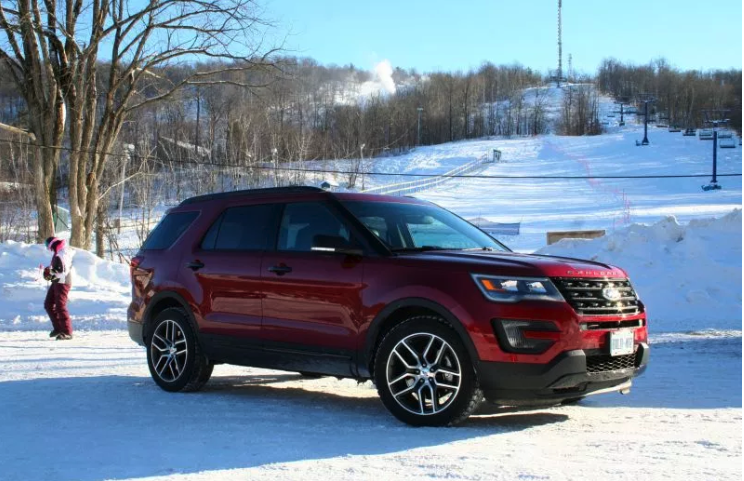Long-Term Test: 2016 Ford Explorer – The Verdict

Story and photo by John LeBlanc
Coming hard after our too-short summers, the dark months of winter can be like purgatory for many Canadian drivers; in truth, dicey winter driving is a big reason why so many buyers opt for the safety and comfort of SUVs and crossovers. This was also the reason we picked a 2016 Ford Explorer Sport midsize crossover/SUV as our 60-day winter test vehicle. And now, after eight weeks of errand-running, family ski days and an international road trip, we are happy to report that the Ford answered many of the questions new buyers in this segment have when it comes to making a decision on their next new Canadian winter driving vehicle.
As we introduced in our first installment, the 2016 Explorer can be had in basic, front-wheel-drive form starting under $35,000. To showcase the thorough refresh the entire lineup received for 2016, we drove a $50,399 Explorer Sport, the next-rung-down model from the $10k more expensive, top-of-the-line Explorer Platinum. At such lofty prices, could a mainstream Ford really be an alternative to luxury crossovers like the Acura MDX or Infiniti QX60? Two months of winter driving would answer that question.
Beyond its Range Rover-ish good looks, the seven-passenger, four-door 2016 Ford Explorer Sport arrived last December with all sorts of goodies standard, including winter-friendly traction at all four wheels, top-dog twin-turbo V6, leather-clad interior, sport-tuned suspension and a variety of other convenience, luxury and safety features. An unexpected luxury touch for chilly winter mornings was not only heated and cooled front seats but also a heated leather steering wheel.
And while we’ve already experienced Ford’s much-improved SYNC 3 infotainment system, the current MyFord Touch system — if not the best in regards to ergonomic design — at least delivers plenty of features. Via a customizable and large touchscreen in the centre dash (plus dual smaller cluster screens flanking the driver’s instrumentation), there are the now-expected full-on audio and navigation capabilities. But the Ford system also offers a live weather tracking map feature, just the thing during our Ottawa to Detroit (and back) road trip in January that saw us traverse through three separate winter storms.
Although it’s marketed as a rugged SUV, most buyers in this segment need the Explorer to behave more like a minivan. How did the Ford stack up as a people hauler? Like many of its rivals, second-row captain chairs in the Explorer are an option; however, the three-across second-row setup in our seven-seat Sport model made more sense when the Ford needed to transport people. It was also roomier than three-row rivals from Chevrolet and Dodge.
During a weekend spent in Whitby, Ontario, hauling around various members of our daughter’s ringette team, the Ford’s third-row seats also came in handy. The Explorer’s class-exclusive power rear seat feature was especially appreciated when this driver’s hands were already full carrying odorous ringette gear. And if you are the type of buyer where the number of digital devices equals the number of passengers, the Explorer Sport offers audio/video input jacks, two USB ports and WiFi capability to keep non-drivers distracted.
During winter days when the sun made rare appearances, our tester’s optional ($1,750) dual-panel sunroof allowed what little light there was to brighten up the cabin. The only interior complaint we heard was that some kids found the thick, inflatable rear seatbelts uncomfortable.
Even when we had a full Ford, there was enough room behind the Explorer’s third-row seating to provide room for winter sports gear; the majority of the time we kept the third row down, which meant plenty of room for our stuff. As you may have surmised by now, as a people and cargo hauler, the 2016 Explorer Sport was a wise choice for our winter test drive; plus, yours truly, the driver, also became fond of spending time behind the Ford SUV’s steering wheel.
The Explorer Sport’s retuned suspension and Toyo Observe GS-i5 winter tires kept the Ford’s body motions well in check, while at the same time delivering a very composed and comfortable ride quality. Offering a level of performance belying its practical ways, the Explorer Sport’s twin-turbocharged, 3.5-litre six-cylinder engine was well-matched to the mandatory six-speed autobox. With 365 horsepower and an equal amount of torque on tap, when the roads were dry the Ford could scoot from zero to 100 km/h in just 6.2 seconds.
Albeit, the blown-V6’s V8-like power also translated into eight-cylinder fuel economy. The best average we saw was an indicated 12.4 L/100 km during our Ottawa-to-Detroit trip. In the end, after eight weeks and 3,399 kilometres of mixed-use winter driving, the Explorer Sport’s average came to 14.5 L/100 km.
Safe to say, after two months of dealing with snowy and icy road conditions, Ford’s popular SUV won us over. In addition to its roomy and tech-laden cabin, the Explorer Sport offered plenty of performance and an excellent ride and handling setup. Its sophisticated and customisable all-wheel drive system, combined with state-of-the-art safety features, made winter driving a stress-free affair. Just be aware that the Sport’s powerful turbo-V6 is no fuel-miser, and infotainment geeks may want to wait for the much-improved SYNC 3.
Nit picks aside, as a substitute for pricier luxury SUVs, we think the 2016 Ford Explorer Sport is an excellent value and a worthy winter warrior.





![[del.icio.us]](https://www.straight-six.com/wp-content/plugins/bookmarkify/delicious.png)
![[Digg]](https://www.straight-six.com/wp-content/plugins/bookmarkify/digg.png)
![[Facebook]](https://www.straight-six.com/wp-content/plugins/bookmarkify/facebook.png)
![[Google]](https://www.straight-six.com/wp-content/plugins/bookmarkify/google.png)
![[Reddit]](https://www.straight-six.com/wp-content/plugins/bookmarkify/reddit.png)
![[StumbleUpon]](https://www.straight-six.com/wp-content/plugins/bookmarkify/stumbleupon.png)
![[Twitter]](https://www.straight-six.com/wp-content/plugins/bookmarkify/twitter.png)
![[Email]](https://www.straight-six.com/wp-content/plugins/bookmarkify/email.png)